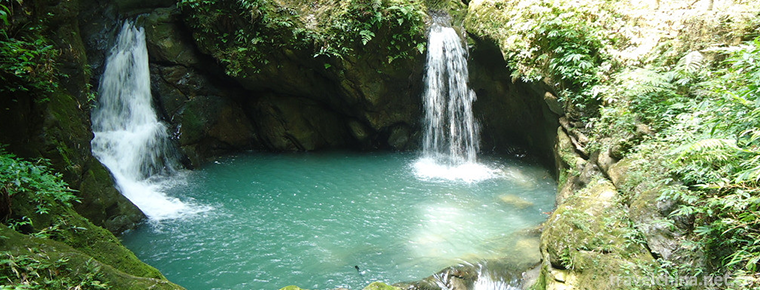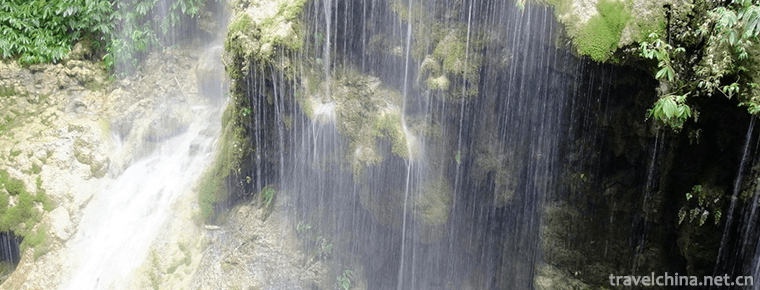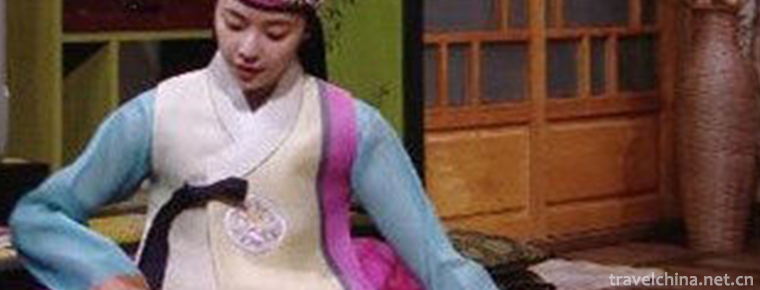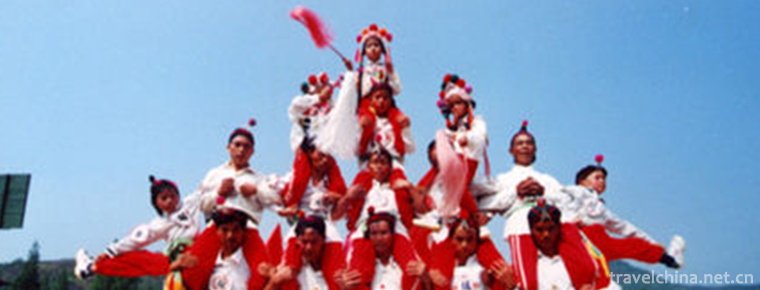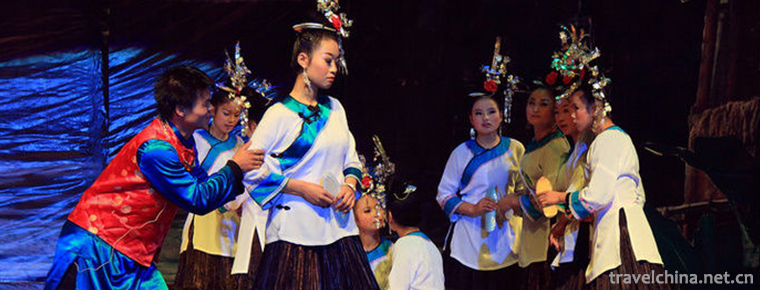Puxian Ten Sounds and Eight Musics
Puxian Ten Sounds and Eight Musics
Puxian Ten-tone Eight Music is not only the traditional folk art folk rap music in Putian area, but also the instrumental music. Ten tones, also known as ten times, are a comprehensive art of instrumental music, vocal music and performance. They are named after ten instruments ensemble, and are divided into two kinds: Wen Ten tones and Wu Ten tones. "Eight Music" is an ancient folk music. "Eight Music" is a percussion music based on "ten tones", which includes Haona, gongs, drums and cymbals, but without gongs. There are one applause, one cymbal in size, one cymbal in size, one Gong in size and one Gong in big and small. Besides percussion instruments, there are eight orchestral accompaniments, so it is called "Eight Music".
In 2014, Puxian Shiyinbayue, declared by Hanjiang District, Putian City, Fujian Province, was listed in the fourth batch of national intangible cultural heritage list with the approval of the State Council.
History of Development
Shiyin, also known as Shifan, is said to have existed in the Song Dynasty and prevailed in the Ming Dynasty. "Yuanshi Li Yue Zhi" contains that every leisure season, or every day after dinner, "Shifan Team" will gather to "Shifan", first drink tea, then play, both leisure and entertainment. Every Lantern Festival night and the village temple god's birthday, there are feasts and festivals, invite the "ten teams" to play. From 89 p.m. to 12 p.m., the invited "Ten Fan Team" can play several tunes before the banquet. On the night of the Mid-Autumn Festival, the "Ten Fan Team" sailed on the river, playing music to celebrate .
During Jiajing period of Ming Dynasty (1522-1566 AD), Huangshi Town of Putian County rebuilt "Beichen Palace" and "Gucheng Palace" in Housucun and Dongsucun villages. According to folklore, every year on March 15 of the lunar calendar, there are exorcise activities. Putian, Xianyou, Fuqing, Pingtan and other counties will bring ten classes to invite fragrance. According to legend, at most 170 classes sang (played) on stream boats, and each of them took turns to sing (played) in front of the Bodhisattva Palace in the two palaces, and to compete on stage. Winners were also rewarded with red envelopes, which were popular until 1949.
In the middle of the Qing Dynasty, Putian Ten-tone School was divided into two schools: the Southern and the Northern Ocean. The Southern Ocean School was dominated by Huangshi, while the Ten-tone Master of Dongducun, Zheng Biaoxian, was good at Pipa and three strings. In the early years of Guangxu in the late Qing Dynasty, "Shiyin" instruments were still used: Pipa, Sanyun, Sheng, Zhao, flute, Laohu, Erhu, Wenzhiqin (Zha Zheng), clapper, Yungong, etc. . Putian County Chronicle records: In the thirty-second year of the Qing Dynasty (1907), Putian Opera Troupes jointly organized the "Ten-fold Competition of the Queen Mother" with the folk. As many as 169 troupes participated. At the end of the Qing Dynasty, Nanyang School was well-known for its ability in playing, followed by flute singing, glide wiping, stringed instrument and bowing method. The Beiyang School, represented by Wu Dao and Qibu Village in the outskirts of the city, is characterized by smooth lyricism and graceful harmony. Xianyou Shiyin can also be divided into two groups, such as the Dongmen Shifan Ban headed by Lin Qisen and the Huixian Shifan Ban headed by Cai Youben. They have bright clothes, neat steps, unified bowing, harmonious tone, emotional singing (playing) and novel repertoire .
Since the 19th year of the Republic of China (1930), the ten tones have changed greatly in terms of playing methods, instruments and tunes. Xiao Zuzhi, Gao Lizai, Huang Jiufei, Cai Youben and Lin Qisen of Putian County have made many beneficial changes successively, which provided experience for the later development of Ten-tone.
In August 1945, in the procession celebrating the victory of the Anti-Japanese War in Xianyou County in the Republic of China, there were more than 100 classes of ten-tone and eight-music classes. During this period, the performing and singing art of ten-tone and eight-music reached its peak. Ten tones and eight music are not only popular in Puxian area, but also spread to other provinces and foreign countries. As early as 1937, 10 people, including Zheng Tianfei and his son Zheng Huanren, from Xiagao Village, Huating Town, Putian County, went to Taiwan Province to perform and produced a large number of Puxian "Ten-note" records. Under the guidance of Peng Wenshuimiao, a musician in Xing'an Yuefu of Xinghua Guild Hall in Taiwan Province, Puxian Ten Tones are often sung. In 1957, at the invitation of the Yihe Bus Company in Kuala Lumpur, Malaysia, Zheng Tianfei and his group of musicians went to teach the singing (playing) skills of "Ten Voices" and participated in religious activities in Singapore and Kuala Lumpur with Puxian folk "feast" music, which further spread Puxian folk music in Southeast Asia .
After the founding of the People's Republic of China, in the procession of welcoming young people to join the army, consoling military martyrs, or festival parades, the "Ten Fan Team" was often used to add a lively atmosphere. They usually line up at the end of the line, playing while walking, walking slowly, so Putian people use "dozens of beats" to describe the Slow Walkers .
Artistic Characteristics
"Ten-tone and eight-music" not only has the ruggedness of northern music, but also the elegance of southern silk and bamboo. Combining with the long-lasting vocal chorus, it adds a strong festival atmosphere to the vast community and the countryside . Its "Wen Shi Yin" melody is slow and its timbre is elegant, while the "Wu Shi Yin" sound is loud and sharp .
The basic characteristics of "Ten Tones" in tune change are melody embellishment and flourishing and emphasis on tune to be beat; the basic characteristics of performance are flute singing and skimming, string instrument short bow and tune, plucked instrument emphasizing "three, five, seven" rhythm. Another characteristic is that it can be played both sittingly and practically. In the performance, bowing is often unified, the pace is neat, and the rhythm is bright .
There are also two forms of "Eight Music" playing, sitting and playing. The gongs and drums are mainly composed of "four grasses", "three discords", "starting drums", "seven beats" and "split mallets". The main characteristics are that gongs and drums penetrate into the singing tune, sometimes highlighting literary music, sometimes highlighting martial music, sometimes both literary and martial arts. It is specially good at playing cards such as "Jiangtou Jingui", "Suzhou Song", "Jixianbin", "White Crane", "Prince Tour Four Gates" and "Lotus Picking Song".
Inheritance
Ten-tone Eight Music Class is an amateur or semi-professional folk association. Its members are mostly farmers, shop assistants, handicraft workers, freelancers and intellectuals. The traditional method of learning art is usually to set up a library by the voluntary fund-raising of the artists. Teachers are invited to teach the skills. Each library lasts forty days and teaches two or three music cards. There are also those who study two or three museums continuously. After learning one or two museums, they can participate in various folk activities. In addition to the festival, wedding and funeral celebrations or farming activities, we can see the singing and playing activities of ten-tone and eight-band music classes. There are ten-tone and eight-band music classes composed of children, young people or the elderly in towns, streets, old people's associations, rural clubs and cultural stations. After 1988, there were also professional classes of ten-tone eight-music and Western wind-blowing music, which were spontaneously organized by the people. They played for wedding and funeral celebrations. There were more than 30 classes in Xianyou County alone.
From 2003 to 2006, the head of Happy Forest Band in Putian City, Fujian Province, played his advantage as a music teacher, created eight Putian traditional music pieces, such as Ode to the Goddess of Peace, to celebrate Mazu's deeds in the form of ten-tone and eight-music.
Putian Xiuyu District Duitou Qihu Primary School set up the school's "Ten-tone Eight-Music" team, which took part in the performance in spare time. On May 31, 2006, a "Qing 61'Ten-tone Eight-Music" performance was also organized.
In the summer vacation of 2006, six veteran artists, Chen Yuanlin and Chen Axiang, from Huiyang Village, Huangshi Town, held a free training course on "Ten Musics and Eight Musics". More than 150 students participated. The oldest was 13 years old, while the youngest was only 6 years old. After more than one month's careful training, more than 50 artists can play "ten tones and eight music" independently.
Xianyou County Political and Legal Committee organized the first Ping An rap troupe to be established in November 2005. By 2010, the rap troupe composed of 16 retired cadres in Longhua Town of Xianyou County had toured more than 2000 performances and educated audiences amounted to more than 100,000. There are also nearly 100 Ping An rap teams in the county, covering 18 townships (streets) and 4 management committees .
As of December 2010, in Huiyang Village, Huangshi Town, there are more than 30 members of the "Eight Music" Team and 15 members of the "Ten Music" Team, and more than 10 children of the "Ten Music Team for Children", among them, the youngest is only 9 years old, and the oldest is 83 years old. Every afternoon, there are bands discussing skills. At the peak, hundreds of villagers gather to play .
In 2013, Putian Experimental Primary School set up a pupil folk orchestra. The school opened a special classroom as a training ground for the folk orchestra, and purchased uniform clothes and most musical instruments for students. Old artists use the time after school in the afternoon for an hour of training, three times a week .
On October 9, 2014, the first "Fengyao Song" Ten-tone Eight-Music Competition of Putian Geriatric Education System was held in the auditorium of the City Geriatric Culture and Education Center. Through this activity, the elderly in Xiuyu District were led to actively participate in the inheritance of the traditional culture of Ten-tone Eight-Music .
Lin Kaishu, as the third group of provincial heritage inheritors of "Puxian Ten Music Eight Music", has taken the lead or assisted in the formation of eight music classes, "Gudian Eight Music" seminars and "Ten Music Eight Bands" in suburban communities. By 2016, more than 200 successor talents have been trained. In order to enable "Gudian Bale Music" to transmit positive energy in the new era, Lin Kaishu also compiled programs such as "Family Planning is the National Policy", "Comprehensive Management of Social Security" and "Scientific Development Concept", and performed in the form of "Bale Music" in the county.
Heritage protection
In 2003, the CPPCC of Hanjiang District of Putian City organized music experts to go deep into Tangtou and Doutou to conduct field research and excavation, write papers and rescue Wen Shiyin .
In 2006, the Cultural Museum of Hanjiang District reported that "Wen Shiyin" of Hanjiang was a list item of Putian intangible cultural heritage .
In 2005, Huangshi Huiyang Shiyin was selected as a folk music category in the first batch of provincial representative works of intangible cultural heritage in Fujian Province .
In 2008, Hanjiang Cultural Museum, with the old artists of the original Jiyou Folk Orchestra as the backbone, set up Jiyou Wenshiyin Orchestra. The instruments used in this orchestra, such as Wenzao, Wanhu, Sixianhu, Sudi, Suxiao and Sandalwood, have all been copied from ancient patterns. Mr. Huang Wendong, a member of the Chinese Musicians Association and one of the ten outstanding inheritors of Fujian folk culture, was invited by Jiyou Wenshiyin Orchestra to teach the ancient Wenji performance and the rehearsal of Wenshiyin Orchestra. Five pieces of music were restored: the episodes of "The Romance of the Western Chamber", "Ten Piano Plays", "Passing through the Western Chamber", "Spring River" episodes "Wind Sends the Yangtze River One Leaf Sail" and "Baihua Pavilion".《 Deeper silence, the episode of "Fairy Gu's Exploration of Diseases" and "Don't Be Invaded by Cold Dew" .
In 2011, Puxian Shiyin Bayue, declared by Hanjiang District and Xianyou County of Putian City, was included in the fourth batch of provincial intangible cultural heritage list of Fujian Province . Lin Kaishu was named the third group of provincial representative successors of "Puxian Ten Sounds and Eight Musics".
Puxian Shiyin Bayue is a kind of traditional music which was approved by the State Council in 2014 and listed in the fourth batch of national intangible cultural heritage list.
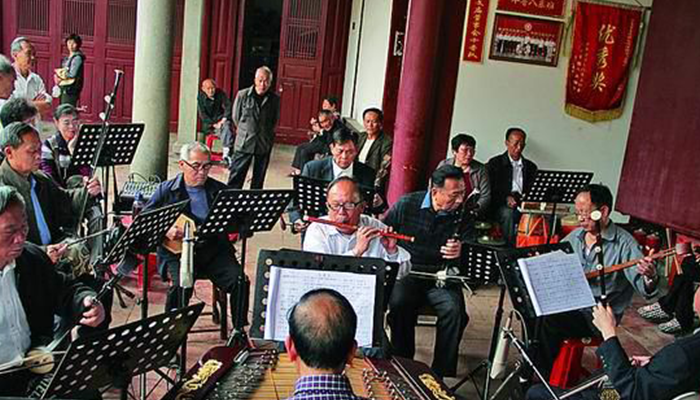
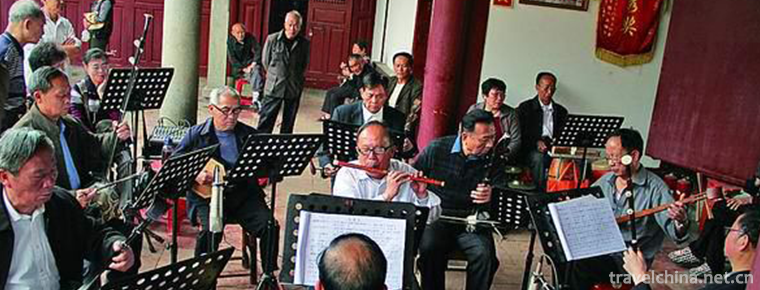
Puxian Ten Sounds and Eight Musics
-
Ning Xia Night Market
Ningxia Night Market is one of the few night markets in Taipei ...
Views: 196 Time 2018-10-12 -
Yungang Grottoes
Yungang Grottoes is located in the southern foot of Wuzhou Mountain, 17 kilometers west of Datong City, Shanxi Province, northern China.
Views: 271 Time 2018-11-24 -
Black Valley Scenic Area
Black Valley, National AAAAA Tourist Scenic Spot, National Forest Park, National Geopark, China's Best Leisure Mountain, China's Best Green Low Carbon Tourist Leisure Spot
Views: 179 Time 2018-12-12 -
Yashan Huahai Stone Forest
Yashan Huahai Stone Forest Tourist Area, located in Nanling County, Wuhu City, Anhui Province, is one of the important scenic spots in Anhui's "two mountains and one lake" tourism economic c
Views: 177 Time 2018-12-20 -
Water Curtain Gorge Scenic Area
Shuixian Gorge Scenic Area is located in the southern mountain area of Jinan, Liubu, the first town of ecotourism in Shandong Province. Covering an area of more than 6000 mu, Jinan's No. 1 Peak Ladder
Views: 198 Time 2019-02-13 -
Gallequin Art
Jia Liqin is made by Jia Xiwang of Jia Liguo, who imitates Chinese Han Zheng. The shape is similar to that of Zheng, and it is also a string and a pillar. There are twenty-one strings in the current G
Views: 200 Time 2019-04-30 -
Ying Luohan
Yingluohan is a form of traditional folk entertainment which integrates martial arts and folklore in the traditional festival activities in Jinyun County, Zhejiang Province. This kind of activity also
Views: 143 Time 2019-07-14 -
Zhulang Niangmei
Zhulang Niangmei is a work of Dong Opera in Guizhou Province. At the end of the Qing Dynasty, Liang Yaoting and Liang Shaohua, Dong opera masters in Congjiang County, Guizhou Province, adapted Dong dr
Views: 152 Time 2019-08-10 -
Hu Bilie Kublai Khan
Kublai was from 1215 to 1294, namely, Yuan Shi Zu, Mongolian, statesman and strategist. regent Torre Fourth sons, Yuan Xian Zong Mongo Brother. Yeke Mongghol Ulus The last generation of Khan, also at
Views: 166 Time 2019-09-07 -
Huanglian earth forest
Huanglian earth forest, namely the earth forest in huanglianguan Town, is a geomorphic landscape developed on a set of ice water freeze-thaw debris flow deposits. Huanglian earth forest is located in huanglianguan Town
Views: 173 Time 2020-10-16 -
Social security in Luzhou
By the end of 2017, the total number of participants in basic endowment insurance in Luzhou city was 2662800, an increase of 130700 compared with the end of the previous year. At the end of the year, 1031700 people participated in the basic endowment insurance for urban employees
Views: 351 Time 2020-12-14 -
Neijiang in yuan Ming and Qing Dynasties
In 1279, China was unified and the Yuan Empire was established. After more than 30 years of war between the end of Song Dynasty and the beginning of Yuan Dynasty, the system of Zizhou and Puzhou has not been restored except Jianzhou. In the 22nd
Views: 290 Time 2020-12-16


